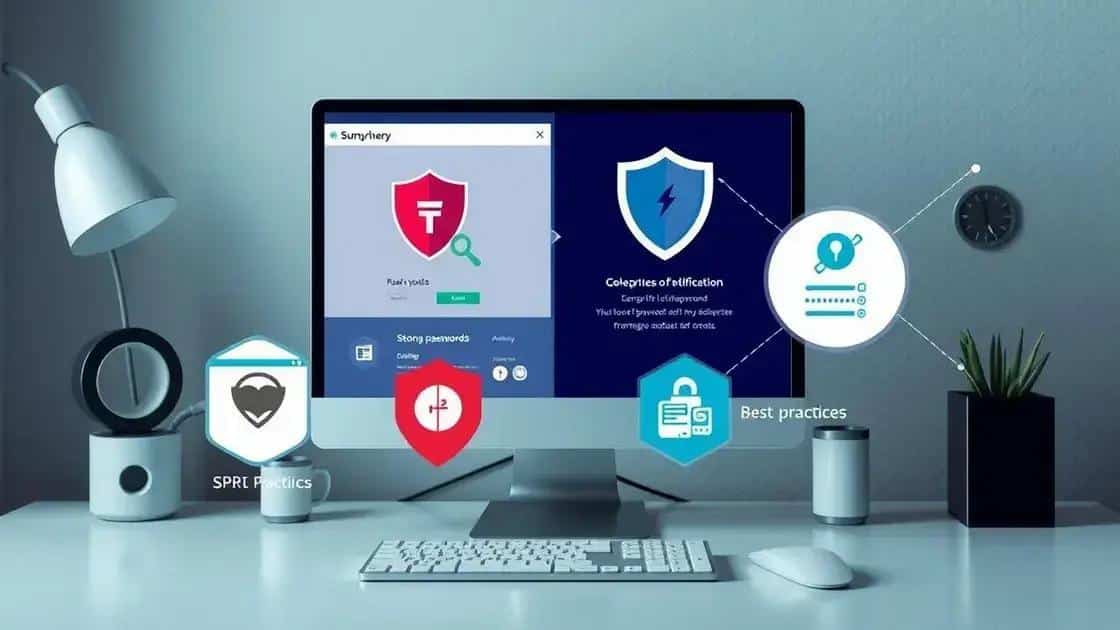Insights on digital privacy tools 2025: What you need to know

Using digital privacy tools such as VPNs, password managers, and two-factor authentication is essential for protecting your personal information and enhancing online security.
Insights on digital privacy tools 2025 are essential for anyone looking to navigate the complexities of online security. As digital threats continue to evolve, staying informed about the latest tools can empower you to protect your personal information effectively.
Understanding digital privacy tools
Understanding digital privacy tools is crucial in today’s online landscape. As more personal information is shared digitally, the need for robust privacy solutions becomes paramount.
There are various types of privacy tools available, each designed to protect specific aspects of your online presence. These tools help secure your data from prying eyes, ranging from individuals to large organizations.
Types of Digital Privacy Tools
When exploring digital privacy tools, it’s important to know the most common types:
- VPNs: Virtual Private Networks encrypt your internet connection and mask your IP address.
- Antivirus Software: Protects your devices against malware and viruses that can compromise your data.
- Password Managers: Safely store and encrypt your passwords, making it easier to maintain secure access across multiple platforms.
- Ad Blockers: Prevent unwanted ads and tracking scripts from monitoring your online behavior.
Each of these tools plays a vital role in ensuring your online security. As we dive deeper into the world of digital privacy, understanding how each tool functions will empower you to make informed choices.
For instance, using a VPN not only secures your internet connection but also allows you to access content that may be restricted in your region. On the other hand, a password manager simplifies the process of creating and maintaining unique passwords for each of your accounts.
The landscape of digital privacy tools is constantly evolving, driven by advances in technology and increasing awareness of data security issues. Staying updated with the latest developments will help you choose the right tools that suit your needs.
As you navigate the complexities of online privacy, it becomes clear that using a combination of these tools is often the best approach. They work synergistically to enhance your overall security. Remember, being proactive about your online safety is key to enjoying a worry-free digital experience.
Emerging trends in 2025

Emerging trends in 2025 for digital privacy tools are set to reshape how we protect our information online. As technology advances, so do the methods and tools used to secure personal data.
One notable trend is the rise of artificial intelligence in privacy management. AI can analyze user patterns and enhance security measures by detecting anomalies more efficiently than traditional systems.
Key Trends to Watch
Here are some key trends that are likely to dominate the privacy tools landscape in 2025:
- Increased Use of Blockchain: Blockchain technology offers decentralized solutions that can enhance data integrity and security.
- Privacy by Design: More companies are adopting this principle, incorporating privacy features into the design of products from the outset.
- Enhanced Biometric Security: Facial recognition and fingerprint scanning are becoming more common, adding an additional layer of authentication.
- Focus on Data Sovereignty: Regulations are emphasizing the importance of keeping data within specific geographical boundaries.
These trends indicate a shift towards a more proactive approach to online privacy. As users become increasingly aware of their rights, demand for privacy-focused tools is likely to grow. Companies are expected to respond by innovating and improving existing technologies.
The integration of machine learning with privacy tools will also become more mainstream, allowing systems to learn user preferences and behaviors to deliver a tailored experience. This not only enhances security but also simplifies the user experience.
Overall, the landscape of digital privacy tools in 2025 looks promising, with innovations aimed at empowering users and protecting their online identity. Keeping an eye on these trends will help individuals and organizations choose the right tools to safeguard their digital presence.
How to choose the right privacy tools
Choosing the right privacy tools is essential for safeguarding your personal information. With so many options available, it’s important to make an informed decision.
Start by identifying your specific needs. Are you more concerned about online tracking, data breaches, or maintaining anonymity? Understanding your primary concerns will guide you in selecting the appropriate tools.
Key Factors to Consider
Here are some important factors to think about when choosing privacy tools:
- Compatibility: Ensure the tools you’re considering work well with your devices and operating systems.
- User Reviews: Look for feedback from other users to gauge the effectiveness and reliability of a tool.
- Features: Check for essential features such as encryption, user-friendliness, and customer support.
- Cost: Determine your budget. Many effective tools are available for free or at a reasonable price.
Once you have a shortlist of potential privacy tools, test them out. Most reputable providers offer free trials. This allows you to explore their interfaces and features before committing.
Another aspect to evaluate is the reputation of the provider. Research their policies on data collection and retention. A trustworthy provider should have a transparent privacy policy. This transparency is crucial to ensure your data is handled responsibly.
As technology evolves, stay updated on new developments in privacy tools. Regularly review your choices to ensure they meet your current needs. As new threats emerge, adapting your privacy strategy is key to maintaining online security.
Best practices for using privacy tools

Implementing the best practices for using privacy tools can enhance your digital security significantly. By following these practices, you can better protect your personal information and maintain your online privacy.
One fundamental practice is to regularly update your privacy tools. Software updates often include important security patches that help protect against new threats. Keeping your tools up-to-date ensures you have the latest protections available.
Essential Practices to Follow
Here are some essential practices to consider when using privacy tools:
- Use Strong Passwords: Make sure to create complex passwords and change them regularly to prevent unauthorized access.
- Enable Two-Factor Authentication (2FA): This adds an extra layer of security by requiring a second form of verification to access your accounts.
- Review Permissions: Periodically check the permissions you’ve granted to apps and services. Revoke access to those that you no longer use or trust.
- Be Cautious with Public Wi-Fi: Avoid accessing sensitive information over public networks unless you’re using a reliable VPN.
Maintaining awareness of your digital footprint is also important. Regularly review the data you share online and adjust your privacy settings accordingly. Social media platforms often have privacy options that allow you to control who can see your information.
Another crucial tip is to educate yourself about potential phishing scams and malicious links. A strong awareness of cyber threats will help you recognize when a situation may compromise your privacy.
In addition, consider using tools together to maximize your security. For example, a VPN combined with antivirus software can provide comprehensive online protection. Combining various privacy tools can create a strong defense against a range of threats.
In conclusion, using the right privacy tools is vital for protecting your personal information online. By staying informed about the latest trends, selecting tools that meet your specific needs, and implementing best practices, you can enhance your digital security. Always keep your tools updated, use strong passwords, and be cautious with your online activities. Remember, being proactive about your privacy not only safeguards your data but also gives you peace of mind in today’s digital landscape.
FAQ – Frequently Asked Questions about Digital Privacy Tools
What are digital privacy tools?
Digital privacy tools are software applications designed to protect your personal information online, such as VPNs, password managers, and encryption software.
Why is it important to update privacy tools regularly?
Updating privacy tools regularly ensures that you have the latest security features and protections against emerging threats.
How can I create a strong password?
A strong password should be at least 12 characters long and include a mix of uppercase letters, lowercase letters, numbers, and special symbols.
What is two-factor authentication (2FA)?
Two-factor authentication (2FA) adds an extra layer of security by requiring a second form of verification, such as a code sent to your phone, in addition to your password.





